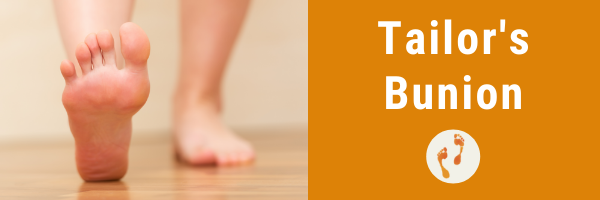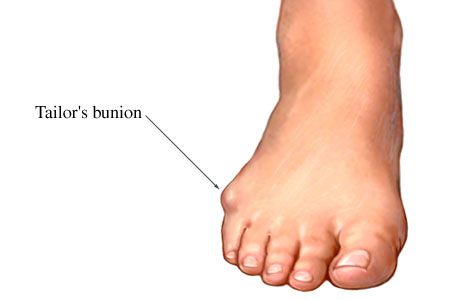
While a regular bunion describes a bony bump at the big toe joint, a tailor’s bunion is the same protrusion but affecting the little toe. It gets its name because a long time ago, tailors used to sit cross-legged on the floor when working, which would constantly rub the outsides of their feet against the shoes and ground, which would cause small, painful bunions on the outside of the fifth toe.
Along with the bony protrusion that can rub against our shoes and cause pain, bunions also change the alignment of the joint and can compromise the function of our toes, which is to help provide balance and support when we walk. As bunions progressively worsen over time, meaning that the joint can progress from being red and slightly swollen to a significant protrusion with the little toe angled in towards the other toes, it’s important to manage bunions early to help stop them from worsening, or at least slowing the rate at which they do.
Causes Of Tailor’s Bunions
 Tailor’s bunions are caused by pressure or friction (rubbing) against the joint. This can be a result of:
Tailor’s bunions are caused by pressure or friction (rubbing) against the joint. This can be a result of:
-
- Regularly sitting cross-legged – as a Pilates or yoga instructor, or how tailors used to
- Regularly wearing tight or narrow shoes that press or rub against the outside of the foot
- Problems or restrictions with your foot biomechanics or structure, which may lead to instability of the joints at the ball of the foot or overloading the fifth toe
- Muscle imbalances
- Arthritic changes to the joints
- Injury to the foot
Treatment
Treating a tailor’s bunion is done according to the level of flexibility available at the joint. For some, their bunion will be rigid and fixed in place, in which case the goal of the treatment is to help offload pressure away from the joint, treat any symptoms like corns that have developed on the side of the bunion, help prevent it from worsening, and keep you as comfortable as possible while you walk.
For bunions that are still flexible, it may be possible to help reduce the severity of the bunion as well as help prevent it from worsening, or slow it’s progress, by using:
- Foot mobilisation therapy to help free up the joints that may be placing pressure on the little toe
- Custom foot orthotics to help correct biomechanical foot problems
- In-shoe padding to alleviate pressure away from the bunion for short-term relief
- Stretching and strengthening program to help with any muscle imbalances
- Footwear recommendations to help support healthy gait and foot posture
We also remove any corns or callus that has built up around the bunion, helping reduce pain and pressure on the joint.
Surgery For Bunions
We consider surgery for bunions as a last resort, as opposed to a first-line treatment. This is because there are many safe, non-surgical options to help manage your bunion that work for many people. Surgery is an invasive procedure that carries risk, has a significant recovery time, has no guaranteed results, and places a big what if on your feet – as it’s impossible to know exactly how the procedure will alter your foot biomechanics and if your feet will start compensating in other painful ways.
Frequently Asked Questions
Is surgery necessary for treating a tailor’s bunion?
No, surgery is rarely necessary – unless it’s causing you immense pain or discomfort, or you’re unhappy with the cosmetic appearance of your feet. Most people can manage their symptoms with things like wearing wider shoes, using padding, taking anti-inflammatory medications, and the like. Beyond this, you need to consult your podiatrist for a customised management plan based on your goals and symptoms
Can a tailor’s bunions worsen over time?
Yes, tailor’s bunions do tend to worsen with time if the causative factors, such as improper footwear, are not addressed. For the best results, aim to book in with your podiatrist as early as possible.
Are there exercises that can help with tailor’s bunions?
Some exercises and stretches may help improve foot flexibility and reduce pain associated with tailor’s bunions – your podiatrist will go through these with you based on your symptoms, as well as the stiffness and severity of your bunion.
Can tailor’s bunions be prevented?
Tailor’s bunions may be prevented or their progression slowed by wearing well-fitting shoes with a wider toe box and avoiding tight footwear – though there are other causative factors that can play a role too.
What is the typical recovery time after tailor’s bunion surgery?
This is something to discuss with your orthopaedic surgeon if you go down this route, but it may take several weeks to months, depending on the type of procedure performed.
Can tailor’s bunions occur on both feet simultaneously?
Yes, tailor’s bunions can develop on one or both feet, depending on the underlying causes and foot structure.
